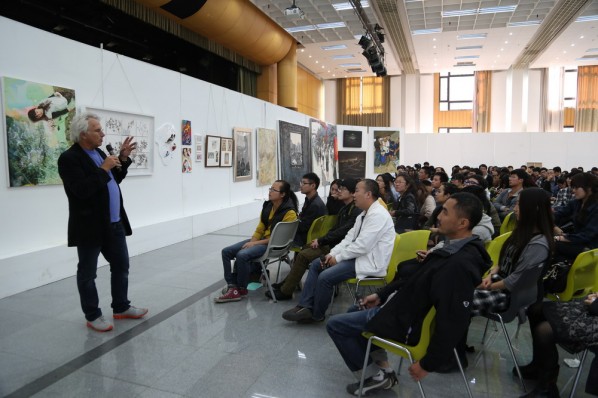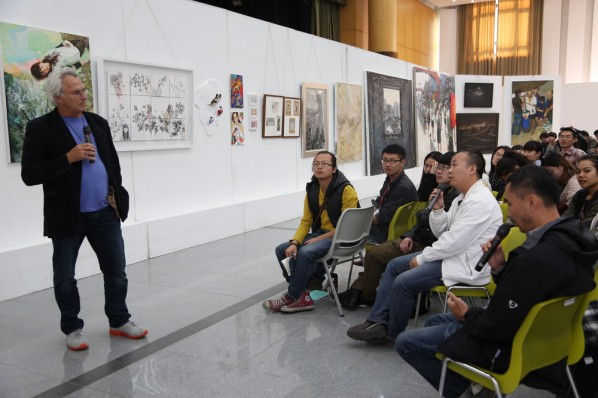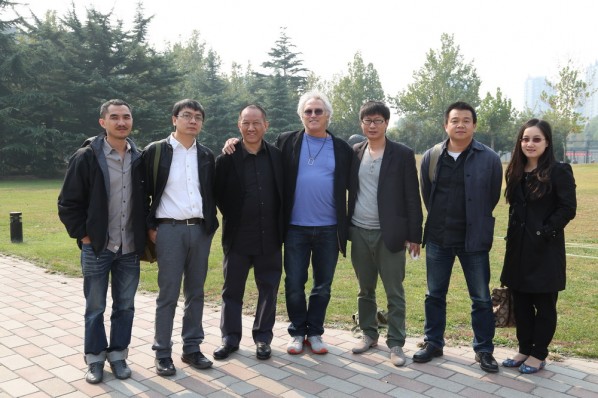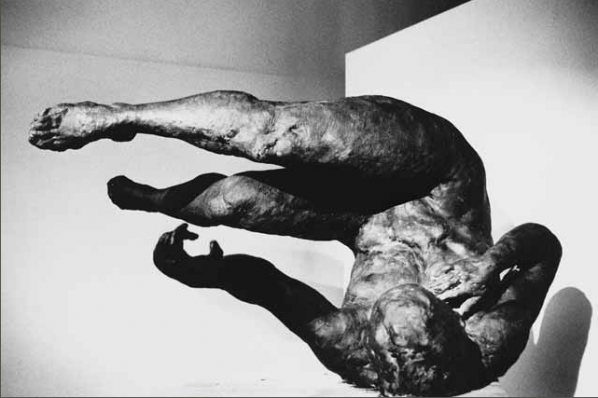
Reasons to Be Persistent
In the 1960s and 1970s in America, installation art and video art developed quickly while painting especially realism painting was on the wane. However, Fishl swam against the tide and chose traditional realism from various art forms as his direction. When talking about his "being out of time", he said "I always greatly differ from the interests of the mainstream art...When I was painting, the tactile sensation of the brush, the smell of the pigments and the flowing of the colors, all characteristics of painting mobilized my body and imagination, that’s why I chose painting. Although I often use photos to create works, I am not good at photography or movies, let alone regarding them as my finished works."
It’s obvious that it is his nonconformist personality and his enjoyment in the state of painting that has given Fishl courage and power to run in the opposite direction from mainstream art. His persistence in traditional easel painting and the outstanding achievements have not only presented the value and vitality of painting but also proved that the modernity of contemporary art lies not in media but in honesty which is always required by fine art as well as a contemplation on life and society. This is of particularly enlightening value for the contemporary Chinese artists who are on a quest.

From the left, Xie Dongming, Eric Fishl, Pan Gongkai and an official of CAFA
Painting and Photography
According to Eric Fishl’s own introduction, wherever he went over the last 30 years, he took his camera with him to shoot figures and scenes attracted that his interest, then he adjusted them by Photoshop. "I replace scenes, determine scenes, replace character images, transform their locations, all kinds of different selections, combinations, collages", which usually constitute a complete picture as the blueprints of his creations. Photographs are essential in Fishl's creations, therefore questions about the relationship between painting and photography are frequently mentioned when conversing.
In Fishl's opinion, when photography first emerged, it strives to imitate the composition of painting to improve its artistry. It was Degas who found the advantage of photography in capturing the moment and saw the opportunity of photography to change painting and let the usage of photography widening the possibilities of painting. To some extent, both photography and painting can capture the momentary reality, but the reality captured by photograph is a thin slice while for painting, the moment is a more complicated construction of time. A mature artist should be capable of finding and presenting the moment which both involves the past and indicates the future.
Tale-teller
Fishl's paintings tend to have a strong narrative, and he often mentions that he is a "storyteller", a great amount of his series paintings are full of vivid stories.
"I always assume various possible story-lines, in order to obtain the ideas and feelings of a painting."A person always turns his head to the left, is this because he comes across people who arouse his curiosity while on the right people enter that he hates? Or it’s just because a fly keeps stopping at his left shoulder? A man bends, is it because he wants to tie his shoelace, to pick up his wallet or because he tripped? And so on. Behind the technical attempts of quite different combinations of various scenes and characters, it is exactly this kind of thinking game and imagination journey.

The Power of Contradictions
During the process of making comments and praising the creations of the students from the Oil Painting Department, it seems that some paintings which contain contradictions like similar disaster scenes with seemingly happy expressions of people, the warm and comfortable rooms and people's unhappy mood always arouse his interest. In fact, this kind of contradiction can also be traced in his works. "People who amuse themselves in gardens, on benches or in well-furnished rooms, in luxurious yachts, as long as we savor them, we will find they are out of tone with the surroundings: they are feeling bored, lonely and they either look others in the eye or peep with a decadent breath. Their behaviors are odd while their minds are wondering if they are in another spiritual world." Some have described the contradictions between the middle class and their environments as revealed in his paintings.
Eric Fishl was born in an upper-middle-class family but his childhood was unhappy because of his alcoholic mother. From his looks, he has a glorious appearance like a well-kept lawn and neatly pressed clothes, however, from the inside, he was full of fear, confusions and disgust because of the tense and volatile relationship with his parents. Maybe it is such an unpleasant experience, that enabled Fishl to realize the humbling power of the contradictions between surface and essence, material and spirit from early on in his life.
The End of Time
When is the completion of a painting? Is it when all the tremendous details are manifested? Or portrayed as photo-realistic? Or the closing date of the exhibition?
Fishl said, “when I face a painting, I do not think of the need to be modified, a mistake is no longer there. The painting is accomplished when I am an audience rather than a creator to care about who is in the painting or what’s happening. It’s finished when this feeling of separation happens.
As a student who finishes his homework, a painting may automatically end with the recognition of the teacher or the end of the course. Fishl’s personal experience was quite beneficial for a young creator on his artistic quest.

Art and Market
Although Fishl has long been the darling of the contemporary art world and his works remain hot in the art market, he once confessed that, “I’m the kind of artist who would like to create with my love of art, I loved and I’m looking forward to gain feedback of love from the audience. But I was thrown into the market which always pays you back with money. Perhaps, money is a neutral thing but artists can buy houses and cars with money and maybe there is a surplus but it’s not love, which will undermine the passion of work.” He complained about it on the first Sino-US Forum on Literature and Art at the end of last year. He thought that people used to talk about the art or the world of art but they talked about the art market when art was mentioned.
The indivisibility of art and commerce however, seems to be unavoidable as an artist Fishl gradually started to understand the envy of commercial art from a positive perspective. Maybe he cannot drum up his support for “be commercial to help” like Andy Warhol did, but he knows that what we need to understand, what we are facing and what kind of contributions we can make for this trend.

Group Photo of Eric Fishl with Teachers and Students of the Oil Painting Department, CAFA
Audience and Ego
Fishl created a bronze sculpture “Tumbling Woman” for the exhibition to commemorate the first anniversary of 9/11 in 2001. Different from most works symbolizing the demolition of the World Trade Center buildings, his sculpture seemed to display the disintegration of the human body which turns the viewpoint of people from mourning to awareness of the vulnerability of life and questioning of the meaning of life. However, it was removed from the Rockefeller Center before the end of the exhibition just because it seemed ruthless in that moment of grief. Fishl was pretty angry with that when he was interviewed at that time.

Tumbling Woman, 2002; Bronze, 94×188×127cm
Creators always hope their works can resonate with the audience but they cannot always accomplish everything agreeable to their wishes. So when Fishl was creating, which is more important, the audience’s feelings or the self-expression of the artist? There are two kinds of audience in Fishl’s heart: the first one includes the artists he worships, his artistic rivals and a variety of critical voices attempt to sway his creation. He wants to gain recognition from them, thus apparently Fishl cares about their opinions. The second type of audience is that which visits the exhibition. For them, Fishl thought, “they might be interested in my work or not and I certainly hope they like and understand these paintings, but I don’t need them. They are so abstract that I do not try to please them.
Many years later when we again asked Fishl if he still felt sorry and unfair that his work “Tumbling Woman” could not be understood, he thought for a moment and said calmly, “ I do not think it was my fault, perhaps it’s not theirs’ either. I think the problem is that it appeared in the wrong time.”
This is the grace and wisdom a mature artist should have, knowing how to self-reflect, be tolerant and what to stick to.





























